 Gratitude is like most desirable traits and qualities in that it is usually not enough to simply decide to be grateful—we must actively practice it to cement its place in our lives.
Gratitude is like most desirable traits and qualities in that it is usually not enough to simply decide to be grateful—we must actively practice it to cement its place in our lives.
There are many reasons why gratitude is such a desirable quality, aside from its inherent goodness. As we recently wrote in a piece on the benefits of gratitude, performing simple daily acts of gratitude can have a big impact on your health and happiness.
These effects are particularly evident in the practice of gratitude journaling. It only takes a few minutes a day, but it can give you a lasting mood boost that can take you from feeling “okay” to feeling “great” on a more regular basis.
If you’re wondering what a gratitude journal is or how you can jump on the journaling train, read ahead to learn everything you need to know about keeping a gratitude journal!
Before you continue, we thought you might like to download our three Gratitude Exercises for free. These detailed, science-based exercises will help you or your clients connect to more positive emotions and enjoy the benefits of gratitude.
This Article Contains:
- What is a Gratitude Journal?
- What is the Difference Between a Gratitude Journal, Planner, Diary, and Notebook?
- Ideas for Items in Your Gratitude Log
- The Gratitude Bullet Journal
- Writing a Gratitude Essay
- Printable Journal Templates
- 4 Gratitude Journal Apps That Can Help
- A Take-Home Message
- References
What is a Gratitude Journal?
A gratitude journal is, quite simply, a tool to keep track of the good things in life. No matter how difficult and defeating life can sometimes feel, there is always something to feel grateful for.
As we express our gratitude, we must never forget that the highest appreciation is not to utter words, but to live by them.
– John F. Kennedy
Even more than that, regularly journaling about the good things in your life can help prepare and strengthen you to deal with the rough patches when they pop up.
It’s extremely simple to start: simply write down (or type) the things you are grateful for on a daily basis. You can use a journal, diary, notebook, or just a piece of paper. If you’re committed to being green or just find it easier to do things digitally, you can use one of the many gratitude apps or even a simple Word document!
If case you’re a mental health practitioner working with clients, you can use a tool like Quenza to share digital gratitude exercises with your clients.
Once you have your journal or app ready, simply start noting the things you are grateful for.
Got a promotion? Journal it!
Mastered a new yoga move? Journal it!
Received good news about a potential health problem? You guessed it—journal it!
It can that easy. In case you’re wondering “What will this practice do for me?” read on to learn about the potential benefits of this simple practice.
Benefits of a Gratitude Journal
We’ve already written about the benefits of a regular gratitude practice, but here are a few benefits people have noticed when practicing gratitude journaling in particular:
- Gratitude journaling, like many gratitude practices, can lower your stress levels;
- It can help you feel calmer, especially at night;
- Journaling can give you a new perspective on what is important to you and what you truly appreciate in your life;
- By noting what you are grateful for, you can gain clarity on what you want to have more of in your life, and what you can do without;
- Gratitude journaling can help you find out and focus on what really matters to you;
- Keeping a gratitude journal helps you learn more about yourself and become more self-aware;
- Your gratitude journal is for your eyes only, so you can write anything you feel without worrying about judgment from others;
- On days when you feel blue, you can read through your gratitude journal to readjust your attitude and remember all the good things in your life (Jessen, 2015).
A yoga enthusiast at Yoganonymous.com wrote about seven of the benefits he noticed when gratitude journaling:
- It can make you more mindful, helping you to become more grounded and also making it easier to notice even more things you are grateful for;
- Gratitude journaling can help you feel more balanced and less thrown off by daily stress;
- You may notice that a lot more small, good things are happening—or maybe you’ll notice the small, good things that were already happening;
- Your gratitude might act as a beacon to good things and good people, drawing even more positive things to be grateful for to you;
- It can make you feel accomplished, even if it’s a relatively small accomplishment. We all need a win, no matter how big or small, every now and then;
- Beware—it might just make you more giving and generous to others! But don’t worry, it isn’t always about money; paradoxically, there are things that actually grow and increase when we give them away, like compassion, empathy, and laughter;
- Gratitude journaling can provide a sense of context or interconnectedness. It can remind us how things in life are connected to one another, and guide us to one of those rare moments in which we truly recognize that the word is so much bigger than us, yet we are grateful just to be a small part of it (Pope, 2016).
If you’re the kind of person who wants that hard evidence in addition to accounts of personal experience, there are studies that back these observations:
- A brand new study of a three-month trial of gratitude journaling found that both reflective (finding things to be grateful for) and reflective-behavioral (finding things to be grateful for and expressing your gratitude) journaling have a significant, positive impact on wellbeing, affect, and depression (O’Connell, O’Shea, & Gallagher, 2017);
- Another brand new study showed that Turkish freshmen who completed a three-week gratitude journal experienced greater gratitude, better adjustment to university life, higher life satisfaction, and enhanced positive affect, compared to a control group of freshmen (Işık & Ergüner-Tekinalp, 2017);
- Gratitude journaling has been shown to help divorced parents forgive their ex-spouse(s), an extremely important step towards positive co-parenting (Rye, Fleri, Moore, Worthington, Wade, Sandage, & Cook, 2012);
- Finally, gratitude researchers in Australia found evidence that gratitude journaling helped school leaders foster a balanced view of the good and bad things that happen at school, use more appreciative problem solving, find value in school-based relationships, and experience more positive emotion, ultimately making them better and happier leaders (Waters & Stokes, 2015).
So, gratitude journaling seems like it has a lot of potential upsides and no noticeable downsides. But how does it differ from writing in any old diary or journal?
What is the Difference Between a Gratitude Journal, Planner, Diary, and Notebook?
 The main difference between a gratitude journal and other similar items, like planners, diaries, and notebooks, is the focus of the action:
The main difference between a gratitude journal and other similar items, like planners, diaries, and notebooks, is the focus of the action:
- Gratitude journaling focuses on what you are grateful for;
- Filling out a planner focuses on what you need to do;
- A diary’s focus is on what happened in your day;
- Notebooks are for taking notes about the present, or future events, to help you remember important points.
Each item has a place and a purpose, but for the most part, they are not interchangeable.
Organizing your week ahead with a planner may incidentally give you things to look forward to and be grateful for, but chances are there will be some events or responsibilities you are NOT so grateful for in your planner.
Likewise, you will probably write down both positive and negative events from your day in a diary, meaning that the focus is not solely on what is good or helpful in your life. Finally, a notebook generally includes value-neutral notes and reminders, rather than lists of the good things in your life.
The gratitude journal is unique in this respect—it is the only item in the range of similar notebooks, planners, and journals that are solely dedicated to noticing and appreciating the positive things in your life. To get the maximum out of your gratitude journaling practice, try to keep it this way.
It’s not inherently bad to write down the negative things that happened or the challenges you faced during your day, but unless you are grateful for it, don’t write it down in your gratitude journal. Keeping your gratitude journal a place for only grateful thoughts will help you realize the benefits of a regular gratitude practice.
Ideas for Items in Your Gratitude Log
Your gratitude journal or log is a personal endeavor that must be unique to you and your life.
No one can tell you what makes the cut for you and your particular circumstances, but there are some suggestions that might help if you’re struggling in the beginning.
Brianna Steinhilber of everup.com drafted a list of 20 gratitude prompts that can get you writing about all the things you have to be grateful for. If you’re stuck at the start, at least a few of these prompts should be able to kickstart your gratitude creativity:
- List five small ways that you can share your gratitude today.
- Write about a person in your life that you’re especially grateful for and why.
- What skills or abilities are you thankful to have?
- What is there about a challenge you’re experiencing right now that you can be thankful for?
- How is where you are in life today different than a year ago–and what positive changes are you thankful for?
- What activities and hobbies would you miss if you were unable to do them?
- List five body parts that you’re grateful for and why.
- What about the city you live in are you grateful for?
- What are you taking for granted about your day to day that you can be thankful for?
- List 5 people in your life who are hard to get along with—and write down at least one quality for each that you are grateful for.
- What materialistic items are you most grateful for?
- Write about the music you’re thankful to be able to listen to and why.
- Who has done something this week to help you or make your life easier and how can you thank them?
- What foods or meals are you most thankful for?
- What elements of nature are you grateful for and why?
- What part of your morning routine are you most thankful for?
- Write a letter to someone who has positively impacted your life, however big or small.
- What is something you’re grateful to have learned this week?
- When was the last time you laughed uncontrollably—relive the memory.
- What aspects of your work environment are you thankful for (Steinhilber, 2015)?
If you’re looking for some more specific examples of the items others list in their gratitude journals, check out Oprah’s five items from her personal gratitude journal on October 12, 1996:
- A run around Florida’s Fisher Island with a slight breeze that kept me cool;
- Eating cold melon on a bench in the sun;
- A long and hilarious chat with Gayle about her blind date with Mr. Potato Head;
- Sorbet in a cone, so sweet that I literally licked my finger;
- Maya Angelou calling to read me a new poem (Winfrey, n.d.).
Since we can’t all be friends with fabulous and inspiring celebrities, here are a few other example items for a gratitude journal:
- The sunrise this morning during your early run or while getting ready for the day;
- A quick text from a loved one simply checking in on you;
- The feeling of slipping into bed with freshly washed sheets;
- Having enough to feed yourself and put a roof over your head;
- Your stress ball, which is so good at calming you down during tense or important phone calls;
- The strawberries you had for lunch today, in the sweet spot between soft and firm;
- Your child’s smile as you tuck them into bed;
- Your Pandora or Spotify playlist that so often plays exactly the song you needed to hear;
- The groceries your significant other brought home from the store (even if they forgot something!);
- The sound of rain falling on your window at night, calming and relaxing you.
While jumping right in and thinking about what you can write in your gratitude journal is an exciting part of the journey, it can get somewhat less exciting as time goes on. On those days when you no longer feel pumped to write down what you are grateful for, it’s good to be prepared.
These tips for maintaining a gratitude journal can help. Lauren Jessen of the Huffington Post blog has these suggestions:
- Plan to write in your gratitude journal every night for 15 minutes before bed. Set an alarm reminder on your phone or schedule it in your calendar. I’ve found that it is easier to write at night so that I can include things that I am grateful for from that day.
- Keep your gratitude journal by your nightstand so you will see it before going to sleep and remember to jot down what you are thankful for. Your journal may even become a symbol of gratitude so that when you just look at it, you will feel a sense of appreciation.
- Write as many things as you want in your gratitude journal. Writing down 5-10 things that you are grateful for each day is a good number to aim for.
- Your gratitude journal doesn’t have to be deep. What you are thankful for can be as simple as “family” or “the new book or movie I recently enjoyed” or “this morning’s breakfast.” What you are grateful for will differ from everyone else (find a list of gratitude books here).
- The timing of when you want to write is up to you. While I try to write in my gratitude journal every night, sometimes it becomes every other night. That’s okay. Journal when it feels right for you—the benefits really are worth it. (Jessen, 2015)
Creating a gratitude journal has even become popular enough for its own “WikiHow” page! For step-by-step directions on how to keep a gratitude journal, you can visit the page here.
Finally, I came upon a set of tips for making sure you are getting everything you can out of your gratitude journal practice. Keep these in mind when journaling, and there should be no obstacle in your way that can stop you!
- Don’t just go through the motions—be conscious about your new “attitude of gratitude.”
- Don’t set a minimum number of things to be grateful for every day—aiming for five things is fine, but accept that there will be some days when you need to gift yourself understanding and flexibility.
- Don’t wait for the “right time.” It’s fine to write something early in the day.
- Elaborate on why you are grateful for the things you write down. This can help you understand what is truly important to you and what you can cut out of your life.
- Focus on people rather than things. It’s okay to be thankful for your smartphone or your car, but the joy you receive from important relationships likely dwarfs your fondness for electronics.
- Don’t rush through the process—try to savor the act of journaling.
- Include surprises in your list. Surprises can provoke a greater emotional response than planned activities and can be excellent to look back on when you’re feeling stuck in the rut of routine.
- Keep the negative out of your journal. As we mentioned earlier, the focus on what is good sets the gratitude journal apart from other forms of journaling, note-taking, and diary-writing—try to keep it that way!
- Variety is the spice of life! Try to list new things as much as possible.
- Be creative—even if you don’t think you’re creative. Feel like adding a picture of your significant other instead of making them into a single line? Do it!
- Give it a chance. The common wisdom is that it takes three weeks to establish a new habit, so aim for at least three weeks of daily journaling before making any judgments. The only thing you stand to lose if you don’t take to gratitude journaling is a few minutes a day—hardly a huge loss (Jensen, n.d.).
Armed with these tips, examples, and guidelines, hopefully, you will find it easy to begin and maintain a gratitude journal! Now all you need to do is find the format that works for you.
The Gratitude Bullet Journal
 While many people who regularly practice gratitude journaling prefer to separate their gratitude by day or week, others like the final product when listing things they are grateful for in one big block for each month.
While many people who regularly practice gratitude journaling prefer to separate their gratitude by day or week, others like the final product when listing things they are grateful for in one big block for each month.
This format is referred to as the gratitude “bullet” journal since each thing you are grateful for can be represented as one bullet point in the monthly block. Many who prefer bullet journals still keep these bullets organized by day, although they tend to use the day of the month rather than the day of the week (i.e., “15” rather than “Tuesday the 15th”).
For an example of the gratitude bullet journal, see the pictures below.
Many who extoll the benefits of the gratitude bullet journal recommend listing one thing, or at least one thing, you are grateful for each day, which may make it easier to start if you are struggling to come up with five items each day.
You could even save yourself some work and purchase dedicated gratitude notebooks that have prompts and inspirational snippets. Pockitudes are pocket-sized journals that serve as a compact reminder to practice and log daily gratitude reflections and are available at many retailers in the US.
Whether you choose a more traditional log of gratitude or a gratitude bullet journal, what’s important is that you commit to feeling grateful every day and stick with it!
Decorating your journal or adding a personal touch or other stylistic flairs can help you stay motivated, so don’t be afraid to get creative. This journal is for you and only you, so do whatever works for you!
Writing a Gratitude Essay
 A gratitude essay is a step further than gratitude journaling—it takes more time, more effort, and more pages.
A gratitude essay is a step further than gratitude journaling—it takes more time, more effort, and more pages.
However, it can have a profound impact on your perspective and spur you to be more mindful and grateful of the good things in your life.
Respected researcher and Journal of Positive Psychology editor Robert Emmons describes his assignment of a gratitude essay as follows:
“Some years ago, I asked people with debilitating physical illnesses to compose a narrative concerning a time when they felt a deep sense of gratitude to someone or for something. I asked them to let themselves re-create that experience in their minds so that they could feel the emotions as if they had transported themselves back in time to the event itself. I also had them reflect on what they felt in that situation and how they expressed those feelings”
(Emmons, 2013).
A gratitude essay is a declaration, a reflection, and an acknowledgment of what you have to be grateful for and, indirectly, who you are. The occasion that you think back to and your reaction to this reflection can reveal a lot about who you are and what you value.
For example, if you look back with deep gratitude on something your mother did for you, full to the brim with self-sacrificing love, you will likely find that you place immense value on family and close relationships with loved ones.
If you reflect back on a helping hand from a teacher, you might be the sort of person who greatly values mentoring, compassion, or the “pay it forward” mentality.
The point is that writing a gratitude essay is not just a great way to acknowledge and reflect on some of the most important or defining moments of gratitude in your life, it is also a way to learn about yourself.
With that in mind, grab a pen or a keyboard, get to thinking about something you are grateful for, and prepare yourself to learn!
Printable Journal Templates
 There are countless templates out there for you to base your gratitude journal on.
There are countless templates out there for you to base your gratitude journal on.
To save you the time of looking through hundreds of templates, I narrowed it down to five different printable templates you can use for your own journal.
Of course, if none of these fit your personal style, there are many others just a few clicks away. As always, find what works for you!
The Grateful Journal
This template is intended for those who would like to meld their gratitude practice with their religious or spiritual beliefs. If you are not looking for mentions of a specific religious figure or deity, continue on for more templates!
Gratitude Journal
For an easy-to-use journal that incorporates a range of useful prompts, try our free gratitude journal worksheet.
The worksheet invites you to start your day by listing ten things you are grateful for. You’re then encouraged to reflect positively on the learning opportunities provided to you by the day’s challenges, as well as the people you are grateful for. Finally, before going to bed, you are invited to reflect on the day’s happiest moment for five minutes–hopefully helping to lull you into a peaceful sleep.
Gratitude Journal, Four Parts
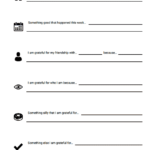 This is a different design than we have discussed so far, but it’s a fun one!
This is a different design than we have discussed so far, but it’s a fun one!
It splits the sheet into four parts, with a part dedicated to morning gratitude (listing things you are grateful for right at the beginning of your day), one corner for writing down what you are learning from challenges in your life, one part to list the people you are most grateful for today, and the final piece dedicated to describing the best part of your day.
This is a fun and unique way to make every day a gratitude-filled one!
Gratitude Bullet Points
If you’re partial to the bullet points style, you may like this template. It includes four separate week columns with space for three things you are grateful for each day.
One nice thing about this template is that you can start your week on whichever day works for you since the days are labeled “Day 1” through “Day 7” instead of Sunday through Monday.
Gratitude Journal, Etsy
If you feel like supporting an independent business owner, there is a great template available for purchase on Etsy.
This instant download is under $10 and includes space to note what you are grateful for each day of the week as well as space to explain why you are grateful for each item. They also have other versions that you may be partial to. Head on over to support a crafty individual and begin your gratitude journey at the same time!
How to start a gratitude journal you’ll actually keep
4 Gratitude Journal Apps That Can Help
As with most problems or tasks in life, there is now an app for that!
If you prefer the feel of a touchscreen over a pen in your hand, there are plenty of apps that support your daily gratitude practice.
Gratitude / Bliss Journal
For example, the Gratitude Journal or Bliss Journal is an old standby in the area of gratitude journal apps. It is available for Android devices and takes up only a tiny sliver of your phone’s memory. Best of all, it’s free to install!
If you’re looking for an app that will guide you through your daily gratitude practice with helpful exercises and prompts, click here to learn more about or download this app.
Gratitude Journal
This Gratitude Journal app is available for download from iTunes, with versions that are compatible with the iPhone and iPad.
This app will only set you back about 45 MB of space, but it packs a powerful punch. It aims for a distraction-free and easy-to-use interface, with easy scrolling and syncing on all iOS devices.
Bonus points—it also uses little heart symbols to track what you are grateful for each day! To see the hearts for yourself or download this app, click here.
Gratitude 365 Pro
This gratitude journal app is available for iPhone and allows the user to incorporate photos, track their journaling by day, and organize with email, Facebook, Twitter, or Flickr calendar.
It’s all in the name with this app, so give it a try if you plan on adding gratitude to your daily practice, 365 days a year! You can read more about it or download it here.
Day One
Another app for iPhone, iPad, and Mac users, Day One helps you keep a digital diary complete with pictures, maps, and notes about your day. This app can cut across devices, presenting you with the same look and format for each platform.
While this app is intended for more of a diary or daily journal purpose, it is easy to use it for tracking your gratitude. You can find it for Mac or for iPhone and iPad in the iTunes store. Click here to learn more about this app.
A Take-Home Message
Starting up a new hobby or practice can be difficult, especially when it’s a practice that can dig up some pretty intense feelings. Don’t be alarmed if you find it to be a difficult, overwhelming, or highly emotional experience at first. Try to lean into the discomfort and keep your commitment to daily gratitude, because greater peace and contentment lie on the other side!
Have fun with your gratitude journal, and remember to make it uniquely “you!”
Have you ever practiced regular gratitude journaling? Are you currently keeping a gratitude journal? Do you have any tips or tricks to avoid some common distractions or difficulties? Let us know in the comments!
For further reading:
- Gratitude Meditation: A Simple But Powerful Happiness Intervention
- The 20 Best TED Talks And Videos on The Power of Gratitude
- The Neuroscience of Gratitude and How It Affects Anxiety & Grief (Incl. Exercises)
- The Gratitude Tree for Kids (Incl. Activities + Drawings)
We hope you enjoyed reading this article. Don’t forget to download our three Gratitude Exercises for free.
- Emmons, R. (2013, May 13). How gratitude can help you through hard times. Greater Good Science Center. Retrieved from http://greatergood.berkeley.edu/article/item/how_gratitude_can_help_you_through_hard_times
- Işık, Ş., & Ergüner-Tekinalp, B. (2017). The effects of gratitude journaling on Turkish first year college students’ college adjustment, life satisfaction and positive affect. International Journal for the Advancement of Counselling, 39(2), 164-175.
- Jensen, L. (n.d.). Turn pain to joy: 11 tips for a powerful gratitude journal. Tiny Buddha. Retrieved from http://tinybuddha.com/blog/turn-pain-to-joy-11-tips-for-a-powerful-gratitude-journal/
- Jessen, L. (2015, July 8). The benefits of a gratitude journal and how to maintain one. The Huffington Post Blog. Retrieved from http://www.huffingtonpost.com/lauren-jessen/gratitude-journal_b_7745854.html
- Marsh, J. (2011, November 17). Tips for keeping a gratitude journal. Greater Good Science Center. Retrieved from http://greatergood.berkeley.edu/article/item/tips_for_keeping_a_gratitude_journal
- O’Connell, B. H., O’Shea, D., & Gallagher, S. (2017). Feeling thanks and saying thanks: A randomized controlled trial examining if and how socially oriented gratitude journals work. Journal of Clinical Psychology, 73(10), 1280-1300.
- Pope, E. (2016, January 12). 7 benefits of creating a gratitude journal. Yoganonymous. Retrieved from http://yoganonymous.com/7-benefits-of-creating-a-gratitude-journal
- Rye, M. S., Fleri, A. M., Moore, C. D., Worthington, E. J., Wade, N. G., Sandage, S. J., & Cook, K. M. (2012). Evaluation of an intervention designed to help divorced parents forgive their ex-spouse. Journal of Divorce & Remarriage, 53, 231-245.
- Steinhilber, B. (2015, November 24). 20 prompts for gratitude journaling. Everup. Retrieved from http://www.everup.com/2015/11/24/20-prompts-for-gratitude-journaling/
- Waters, L., & Stokes, H. (2015). Positive education for school leaders: Exploring the effects of emotion-gratitude and action-gratitude. The Australian Educational and Developmental Psychologist, 32, 1-22.
- Winfrey, O. (n.d.). What Oprah knows for sure about gratitude. Retrieved from http://www.oprah.com/spirit/oprahs-gratitude-journal-oprah-on-gratitude
Let us know your thoughts
Read other articles by their category
- Body & Brain (49)
- Coaching & Application (57)
- Compassion (26)
- Counseling (51)
- Emotional Intelligence (24)
- Gratitude (18)
- Grief & Bereavement (21)
- Happiness & SWB (40)
- Meaning & Values (26)
- Meditation (20)
- Mindfulness (45)
- Motivation & Goals (45)
- Optimism & Mindset (34)
- Positive CBT (28)
- Positive Communication (20)
- Positive Education (47)
- Positive Emotions (32)
- Positive Leadership (18)
- Positive Parenting (4)
- Positive Psychology (33)
- Positive Workplace (37)
- Productivity (16)
- Relationships (46)
- Resilience & Coping (36)
- Self Awareness (21)
- Self Esteem (37)
- Strengths & Virtues (31)
- Stress & Burnout Prevention (34)
- Theory & Books (46)
- Therapy Exercises (37)
- Types of Therapy (64)
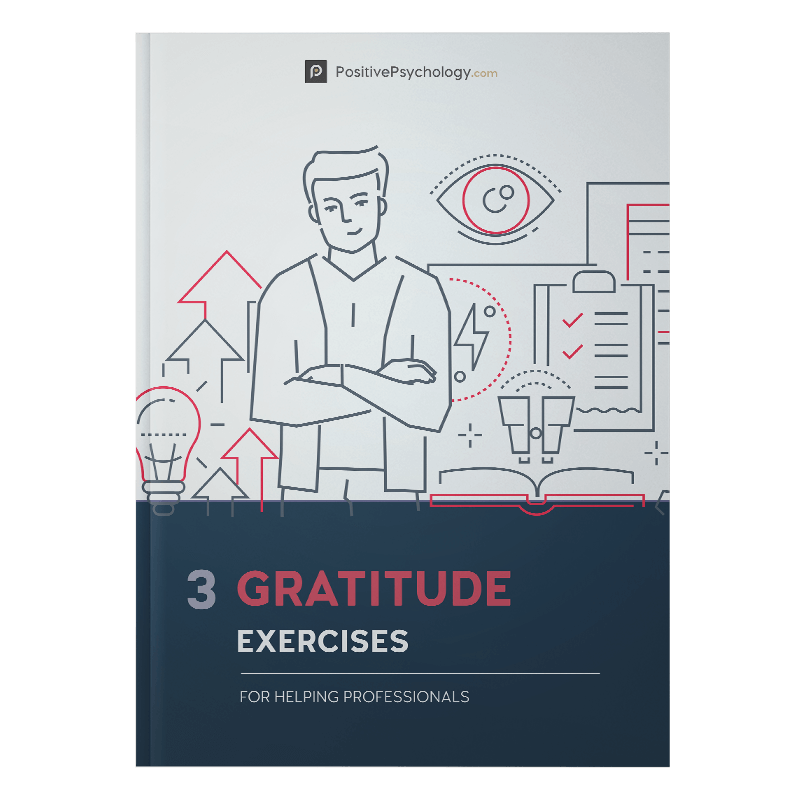
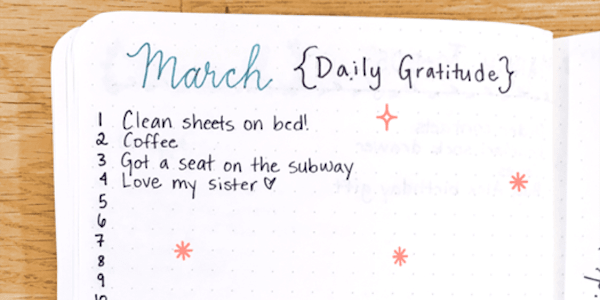
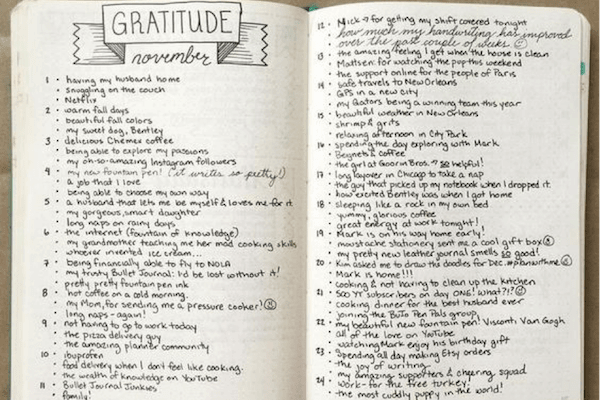
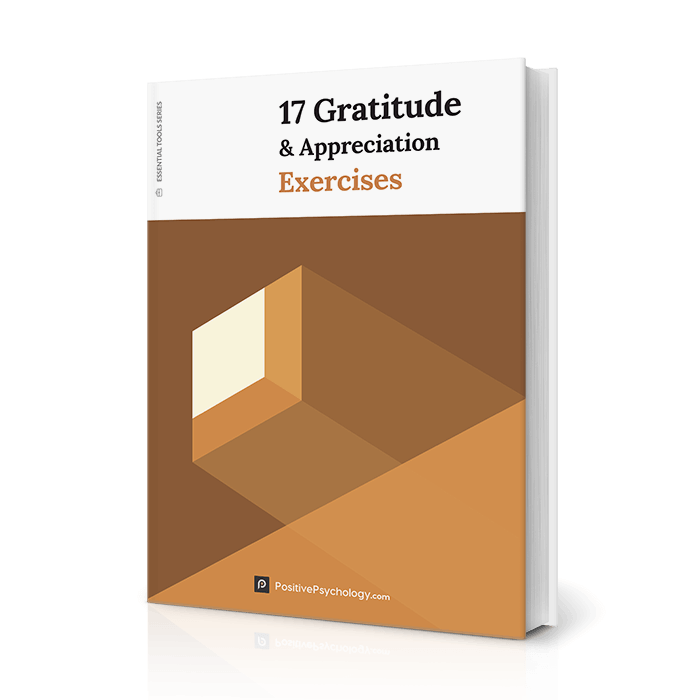



What our readers think
Thank you so much for this! I learnt a lot more about how to write and be consistent with Gratitude journal writing. It has profound knowledge here! I had a question about how can daily writing be an interesting and joyful journey, I got that answer here!!
The digital world has never been the same after reading your blog post. Your unique viewpoint and thoroughly researched writing provide a thorough analysis of the topic, enhancing the online community with insightful knowledge. Your dedication to producing outstanding content is admirable, and it improves the conversation online. I appreciate you sharing your knowledge.
I wanted to thank you for this excellent and very effective backlinks! Thank you so much for this.
I’m going to read this. I’ll be sure to come back. thanks for sharing. and also This article gives the light in which we can observe the reality. this is very nice one and gives indepth information. thanks for this nice article…
Courtney, I loved reading this article. I will be looking into more of your posts to read in the future. I am just starting as a mental health blogger, and you are my image of success! I felt so inspired looking through your blog and your other work. I can’t wait to read your books!!
I definitely perfect driven in making getting some site, that i save been unfavorable to try and conduct to add a long time around. Appreciates for that reason win over, this is certainly functional!
Just starting my journaling journey at 57, but better late than never… as they say.
As a “newbie” I felt a little out of my comfort zone expressing my feelings on paper, and actually wrote on page one/day one, “Today I am grateful for nothing, sadly!” Not exactly the best start?
However having read your article I crossed out my entry and expressed my gratitude for you taking the time to write this post and passing on your wisdom to me.
Thank you so much for this article.
Nice!
Courtney! This is such a great article to signpost people to! I’m really grateful! Ha x Excellent stuff
Thank you for posting this . I am filled with negativity and finding a way to get rid of it through a gratitude journal and I thank God that I found your site. I will come back in a week to write down my progress. (God willing).